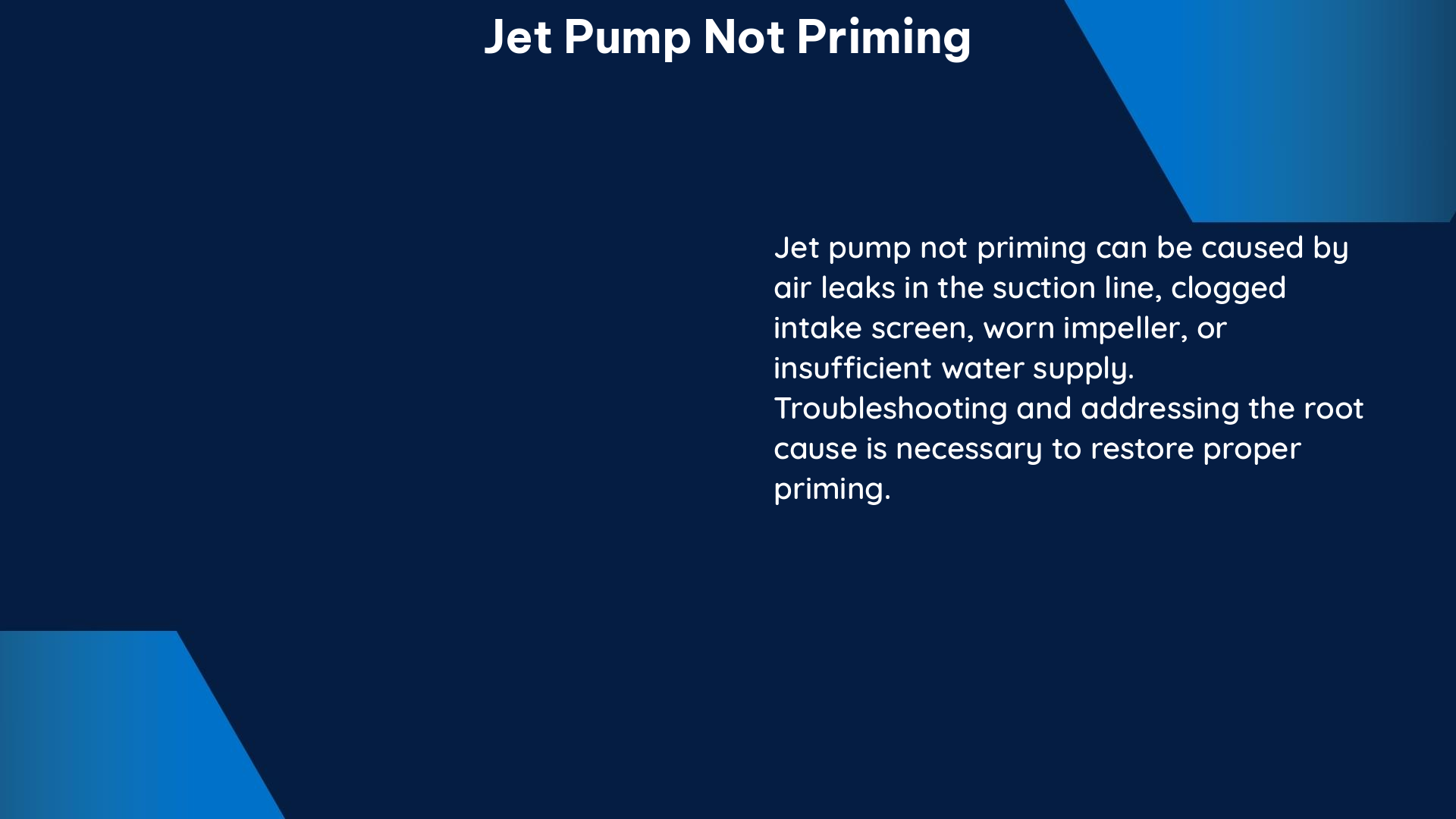Jet pumps are essential for drawing water from wells, but they can sometimes fail to prime, causing issues in water supply. This problem can be caused by various factors, including a faulty check valve, suction leaks, or a stuck or leaking foot valve.
Understanding the Jet Pump Priming Process
Jet pumps work by creating a vacuum that draws water from the well into the pump. This process is known as priming, and it’s crucial for the pump to maintain its prime to continue operating effectively. The check valve or foot valve, located below the jet, plays a vital role in this process by preventing water from flowing back into the well.
Common Causes of Jet Pump Not Priming

- Faulty Check Valve or Foot Valve:
- The check valve or foot valve should be located below the jet and should be in good working condition.
- If the valve is stuck open or has a rock or debris obstructing it, the pump may not be able to maintain its prime.
-
Check the valve for any signs of wear, damage, or obstruction, and replace it if necessary.
-
Suction Leaks:
- Suction leaks in the system can prevent the pump from creating the necessary vacuum to draw water from the well.
- Inspect the suction line, fittings, and connections for any cracks, holes, or loose connections that could be causing air leaks.
-
Tighten or replace any faulty components to eliminate suction leaks.
-
Clogged or Blocked Intake:
- The pump’s intake, which is the opening where water enters the pump, can become clogged or blocked with debris, preventing the pump from drawing water.
-
Inspect the intake and clean or remove any obstructions to ensure unimpeded water flow.
-
Incorrect Priming Procedure:
- Proper priming of the jet pump is crucial for it to function correctly.
- Ensure that you are following the manufacturer’s instructions for priming the pump, which may involve filling the pump housing with water or using a priming port.
-
If the pump is not primed correctly, it may not be able to create the necessary vacuum to draw water from the well.
-
Worn or Damaged Impeller:
- The impeller, which is the rotating component inside the pump, can become worn or damaged over time, affecting the pump’s ability to create the necessary vacuum.
-
If the impeller is worn or damaged, it may need to be replaced to restore the pump’s priming capabilities.
-
Incorrect Pump Sizing:
- If the jet pump is not properly sized for the well depth and water demand, it may not be able to generate enough suction to prime effectively.
- Ensure that the pump is correctly sized for your specific well and water usage requirements.
Troubleshooting Steps
- Check the Foot Valve:
- Locate the foot valve, which should be installed below the jet and the pump’s intake.
-
Inspect the foot valve for any signs of wear, damage, or obstruction, and replace it if necessary.
-
Inspect the Suction Line:
- Examine the suction line, fittings, and connections for any cracks, holes, or loose connections that could be causing air leaks.
-
Tighten or replace any faulty components to eliminate suction leaks.
-
Clean the Pump Intake:
-
Inspect the pump’s intake and remove any debris or obstructions that may be preventing water from entering the pump.
-
Prime the Pump Correctly:
- Follow the manufacturer’s instructions for priming the jet pump, which may involve filling the pump housing with water or using a priming port.
-
Ensure that the pump is filled with water before starting it.
-
Check the Impeller:
- If the pump is still not priming, the impeller may be worn or damaged and in need of replacement.
-
Consult a professional or the manufacturer for guidance on impeller replacement.
-
Verify Pump Sizing:
- Ensure that the jet pump is properly sized for your well depth and water usage requirements.
- If the pump is undersized, it may not be able to generate enough suction to prime effectively.
Preventive Maintenance
To prevent future priming issues, it’s essential to perform regular maintenance on your jet pump system:
- Inspect the Foot Valve: Check the foot valve periodically for any signs of wear or damage, and replace it if necessary.
- Clean the Suction Line: Regularly inspect and clean the suction line to remove any debris or obstructions that could cause air leaks.
- Monitor Pump Performance: Keep an eye on the pump’s performance, such as pressure and flow rate, to detect any changes that could indicate a problem.
- Follow Manufacturer’s Recommendations: Adhere to the manufacturer’s recommended maintenance schedule and procedures to ensure the long-term reliability of your jet pump.
By following these troubleshooting steps and implementing a preventive maintenance routine, you can effectively address and prevent jet pump priming issues, ensuring a reliable water supply for your home or business.
References:
- Plumbing with Tim – YouTube
- Pirate 4×4 – Priming a Water Pump Problems
- Lawn Care Forum – Jet Pump Runs but Won’t Build Pressure
- Love Plumbing & Remodel – Jet Pump Can’t Prime
- DoItYourself.com – Pump Not Priming with Weird Pressure Events

The lambdageeks.com Core SME Team is a group of experienced subject matter experts from diverse scientific and technical fields including Physics, Chemistry, Technology,Electronics & Electrical Engineering, Automotive, Mechanical Engineering. Our team collaborates to create high-quality, well-researched articles on a wide range of science and technology topics for the lambdageeks.com website.
All Our Senior SME are having more than 7 Years of experience in the respective fields . They are either Working Industry Professionals or assocaited With different Universities. Refer Our Authors Page to get to know About our Core SMEs.